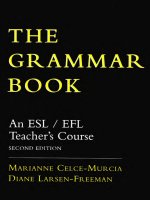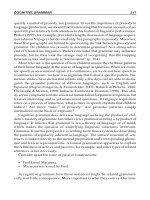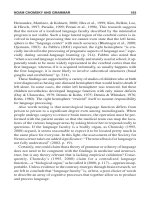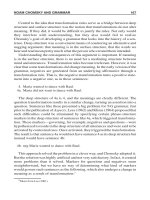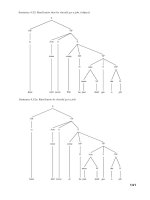The teacher''s magazine chronological order
Bạn đang xem bản rút gọn của tài liệu. Xem và tải ngay bản đầy đủ của tài liệu tại đây (2.28 MB, 32 trang )
EDIBA
runla
0
•
Blessings
Calligrams
Oral presentations
and public speakIng
Global Culture Cal fr
Dear
In this issue you will find useful resources to enrich
your classes.
The picture
stories presented on both posters will ease
your task when
working
with students oral or written
production.
Suggestions
for using
calligrams
in your class
provide numerous
ways of involving students with Language and Art.
Cute
Antarctic
penguins will lure young
learners
into attractive
activities involving English
and
Maths.
Some
useful
advice on public speaking
rules
will help older
students to plan, prepare and deliver effective oral
presentations.
We hope you like these and the rest of the materials in this
edition.
The Thacher's
Magazine
team
L
Rd(R. Rbb,
JzCa, C,rn kImV
l ,,O
e.*.O.,,.I
WLS.ba.
Lfl.ID.p* M-lOflI
l,SPNNP.thuthsbn EdbEWEON
11,
S
0R214r1h1.N a.zm,a,d),&a a an. G,.d.6R.z.y 1,I
SI 3527
P
~
b
I S.t2Ps
M. 11
352a1 K
.35t 275 5, 235,P5.y IJ.&a /P1Md by. UsS1&Ifl2sC2SS.s2d2sS.LL1ISkSIMIssi
MIII
1" 11
11,
.11111,11
GFOJPO
FDIBA
Gntowww.ediba.cnm to contact us.
nnnon
wm2uuhftancuaaScoucuudo
,
7azc23ccu22oa.s Sno(2
,
VA7fro*ouoo.csna,parpScc
Contact:
___________________
Poland
/ www.ediba.com
Spain
Tel.: +22 566 77 87
All information in our web it
www.ediba.com
Ohm
By
Phone:
91352 09 18
By Fax: 91 7155875
Czech Republic
Contact:
tNWVst.Seiid.CZ
Getting down to work
Ghregjcatntr
Pictttre stor
ies on posters 1 and 2
tt
*
'here are several ways to organise a piece of
'
writing. Today we are going to deal with one of
them, that is, chronological order or time order.
t This is the appropriate pattern to arrange ideas or
events in the order in which they occur. Therefore,
we are presenting two posters with pictures showing a wide
variety of stories the students may tell and write while they
learn to put their ideas in order before writing.
Before working with the posters and the activities suggested in
this edition, explain to your students that when we tell or
write a story we shouldn't let our thoughts wander. We
usually follow the order in which events occur and we use
words called
signal words
to arrange the events correctly in
order to make our story more interesting and clearer to the
listener or reader.
To follow this pattern or organisation we use signal words
such as next, then, the
following
morning, a few hours later,
still later, that Wednesday, by noon, when site was seventeen,
before the sun
rose,
that July, eventually, following this, after
some time, finally, first, second, meanwhile, during, until,
and
so on. Write the list on the board.
Tell the students that their pieces of writing should answer the
questions When did it happen?
And
In what order did it
happen?
Remember!
Chrono = time
Logic = Order
Stories are told chronologically,
or in order of time.
What happens if we don't follow a logical order
in our stories?
Readers always took for patterns to help make sense of the
information they read. When they are not able to find a
pattern, they get confused and lose interest in the text. Then,
if writers follow clearly organised ideas and a logical pattern,
the message will gel through. So the key point is to think
carefully about which kind of structure or organisation will
help the reader to better understand the information.
The stories in the posters will provide you with lots of
material to teach or review vocabulary. Show the posters to
your students and in small groups have them choose a story to
discuss. They will list the vocabulary to be used and the signal
words they consider necessary. Walk around the classroom to
provide any word they do not know to add to their lists. Once
they have finished, they will write a draft of their stories. Later
they will edit it and do the final version which will be
presented to the class.
You may want to start with the photocopiabte activities on
pages 6 to 11. In most exercises the students have to put the
story in the right chronological order and write sentences or
paragraphs using the vocabulary given.
The exercises may be presented as a game if you previously
make copies of the pictures, cut them out and put them in an
envelope for the students to form the sequence. You could
even mix up two or three stories and have them separate
them.
As we always say, you can adapt these activities to your
students' level or choose, among the pholocopiables, the one
that best suits your needs. The following are some examples.
4
1
1000
Go to www.ediba.com
J
and download all the picture
stories to photocopy.
Mum's hard day
Picture i
Yesterday Mum
came back from
work when we were
watching TV.
Picture 2
Then, she went to
the kitchen. What a
mess! There were
lots of dirty plates
and pots!
Picture 3
When she finished
washing the dishes
and cleaning the
kitchen, she sat in
her favourite
armchair. Then, we
prepared a delicious
snack for her. She
looked so tired but
eventually she was
happy to have a
good rest!
Picture i
Last Saturday I didn't feel very
well. Mum touched my forehead
and said perhaps I had a
temperature.
Picture 2
Next, she took my temperature
with the thermometer.
Picture 3
Pretty soon, the doctor came
home. He told me to get into bed,
then he checked my lungs and
heart with his stethoscope.
Picture 4
When the doctor went away, Mum
gave me some syrup that tasted
strawberries.
Picture 5
While I was in bed, my friends
came to visit me. That was the best
part.They made me feel much
better.
Picture 6
After some days, I was not sick any
more and I could get back to
school, That was great!
V,
Level Flenetary-
Age AU
A STORY IN CHRONOLOGICAL ORDER
A) Look at the pictures and number them in the right order.
"
0
B)
Complete the sentences with the simple past of the verbs in the box. Underline the signal words.
dig - sow
- water - begin
1) First, Jimmy a hole in the ground. Next, he a seed.
21 Then, he it.
3) After some days, a beautiful plant to grow.
C)
Use the example above to write three sentences to explain another sequence.
21
31
KeyrA)a-2; b-u; u-i. BIll duu, rowed; 21 watered; a) began
Level Elementary+
Age All
STORIES IN CHRONOLOGICAL ORDER
A)
Put the pictures in the right order and match them with the correct sentences. Underline the signal words.
°cm
11
First, she picks up the nicest apple.
21
Next, shetakes a kxife.Then, she peels the apple with the knife.
31
Finally, she eats the delicious apple.
B)
Put the pictures in the right order and match them with the correct sentences.
f
0
11
One day, Peter was walking through the park. It was not a good day.
21
First, he didn't watch his steps, so he tripped over a stone.Then, he fell down.
31
Finally, ouch! He hurt himself and mum was not arousdl
KeyrAl a-3, b-i, c-2, B) e-2,b-i,n-3.
Level: Elementary
+
Age: All
A STORY
N CHRONOLOGICAL ORDER
Putthe pictures in the right order
and write the sequence. Finish the sentences.
1)
Firstly
2)
Secondly
5)
After
that
6)
Lastly
Iceysil d-I puree nsyunderuvear;2)f- I puton
my:ockc3) b-I paton rnytreuoere4lu- I putos roytraiserui5) a- I poton ryt-ohirt6) e-1 patonrtty
iacket.
8
1) Yesterday afternoon, Tommy on a bus.
I
WI'
V
1*
Level: Pre-intermediate
Age: All
A STORY IN CHRONOLOGICAL ORDER
First of all , courtesy
A) Tommy shows respect for a mum who is having a baby. Put the pictures in the right order, complete the
sentences and underline the signal words.
'IN
low
Key: 1) b was sitting; 2) a- stopped,
not
On; 3) a - stood op. :3 down.
Level: Elementary -
Age: Al
A STORY IN CHRONOLOGICAL ORDER
A)
Look at the pictures, put them into the right order and draw the pictures that are missing.
'I
p
lv
0
I
I
B)
Put the sequence in order and match the sentences with the pictures.
1)
Then, Pip came out of the egg.
(
2)
After some days, a chick broke the shell.
3)
Lastly, Pip turned into a beautiful young rooster.
4)
First, Mrs Hen laid an egg.
5)
Next, Pip
hungry
delicious
got
and pecked at some
seeds.
K.y:Alr) ;2l ;3)b;4lc5)c.Bt4,2,1,5,3.
10
Level F ementry +
A STORY IN CHRONOLOGICAL ORDER
Put the pictures in the right order and write the sequence. You can use the words in the box. Remember to
put the verbs into the right tense.
firstly - secondly - then . next
after that - before . lastly - to fall off -
test - to pick up - to take care - box- to pat into - cage - to free
* Calli8cams are poems or phrases that are arranged
'
in such a way that their shapes describe the idea
that the words express. The lines create an image
' that is related to the poems content. In other
words, calligrams are a piece of text in which the
design and layout of the letters create a visual image related to
the meaning of the words themselves. For example, a famous
artist, Guillaume Apoltinaire, born in 1918, published the book
Calf fgrames,
and wrote a famous calligram about The Eiffel
Tower shaped as the tower itself.
This type of poetry is also called shaped poetry, pattern poetry
or concrete poetry; the word calligram means
beautiful
writing.
The typeface, font or handwriting is also important to
reinforce the meaning or ideas of the poem.
Tips for the class
These types of poems are very useful, since they can provide
numerous ways of involving students with language and art.
Here are some ideas to exploit calligrams:
If you are working with beginners, you can start with words
such as fat,
short, tall,
bar code, grew, bridge, circle, blurred,
shaky,
scared,
happy, sad, angry,
rectangle,
copy, zigzag, curly,
plain, small, big,
and
cup.
•
If your students have tried working with words, but they do
not feel so confident to work with poems yet, you can try
something in-between: draw the shape of an object with
words, i.e. the picture of a table would be formed with the
word
table
(for the top of the table) and four words
leg
(to
form the legs); the picture of a cat would be formed by one
word cat (for the body), two words
ear,
one word tail and four
words
leg.
•
You may want to work with sentences, e.g. a sentence about
family in the shape of a heart; a sentence about nature in a
shape of a tree; some thoughts about friendship in the shape
of a happy face; ideas about students' pets in the shape of an
animal; learners' list of favourite food items in a related shape;
kids' favourite music, singers or bands in the shape of
headphones.
•
Calligramo supply students who love computers with the
chance of working with different programs such as WordArt,
Paint, Corel, etc. There are also useful websites, such as:
'www.wnrdle.net/
•
www.imagechef.com/icfword_mosaic/
'www.imagechef.com/ic/poem/
croD
B,
J,ruf
cbo
r)
-lit
V2
EMMOp
'
94
SIR
IRS
12
goo
•
Learners who love arts and crafts
can turn calligrams into lovely art
projects in which they may include
different materials, not just pen and
-
paper.
•
Using the fonts that everybody can
find in a word processor, like
9,
WideLatin, Vivaldi, Tempus Sans, etc,
students can create poems with ideas
inspired and based on such fonts.
•
These videos may also give students
some ideas:
•
www.yoatabe.com/watch?v=IsFXv6CmDK-4
•
www.youtube.com/watch?v=ZbbeL4dVfxM
•
www.youtabe.com/watch?feature=endscreen&s=
EPY-FZT9ME8&NR=l
Calligrams are great to work with because the
combination of words or sentences with an
image contributes to foster students' creativity.
Aurea Obeso
[HEAT[D AN AT GAURY IN THE (LASSHUOM
and oadqe
- OF HIS PLASTIC ARTS WORKSHOP
FIND INSPIRING AND EDUCATIONAL
ACTIVITIES LIKE THIS ONE IN
C&thED
IBA
FOLLOW US
Join the community of those who are passionate about education at
WVAY.CLUB.EDIBA.COH
f
Level: Beginners
Age: Children/Adolescents
DREAMING ABOUT THE HOLIDAYS
Alice hates cold weather so she is dreaming about her next summer holidays on the beach. What is she
going to do? Write about her future plans.
Relax in the
Swim in the sea
°
Rag
Take lots
,
oicttres
(
Ero!the
hot weather
'
Ljstemi to
1
mnttSiC
,
1
-
.
Wear mSwim
Ker.
A) I'm going to sunbathe; I'm going to swim in the tee; I'm gong to relax in the son; I'm going to take lots of pictures; I'm going to ploy volleyball-,
I'm going to enjoy the hot weather, Inn going to listen to music; I'm going to Wear my swimsuit.
14 *
00
Level: Elementary
Age: Chidren/AdoIescents
G
RAMMAR WAVES
B) Alice is dreaming of surfing. Help her to catch the wave!
Complete the sentences with the right option.
,1.f
.
j)
not no doesn't don't
0
like srj
waves.
-
1
2)
ride
is ride
rides
is
jfg
C
j-
rjen
~
MY
a
enormous waves.
3)
am
are
1
72y
£rterid.S andl
Camping on
the bench
"\
4)
have has am
do
a
rea board Th is
perect
Keyr B) 1)1 don
'
t like small waves; 2) My friend always rides errow005 waves;
3)
My friends and I are camping on the beach; 4)1 have a great board. It is
perfect!
15
Level: Beginners
Age: Children
RIDDLES
It
r
eryentertaining.
It has got a car
you how to make tea.
But no wheels.
Or how to catch a bee,
It has got a pet
If you watch it for hours
But no fleas.
You are not tree!
It's something that you chew.
That's my first clue.
0
It's usually mint
That's my second hint.
If you chew till noon,
You'll get a balloon.
F
Mary's father had five daughters:
Lala, Lele, Lill, and Lob.
D
What's the name of the last
daughter?
P
It can fly.
It has butter in it
But you cannot eat it.
I'm long when I'm young
I'm short when I'm old,
When therein no light
People think I'm gold.
G
laminme
lam in here
What is in the center
I
in her
of the Barth?
But I'm not in you.
. . .
. . . . . . . .
What has got arms
but cannot touch?
i6
KwnAItheTV; SI chewing gum; cia carpet; DI a butterfly; El a candle; F) Mary; SI letter E; II) an armchair;
I) letter R.
Level: Beginner
COLOURFUL WEEK
Age: Children
Read the poem and colour the girls
clothes. Then chant together!
Pk is
mi
Lavourite
on Monday.
'I
Thd is my
£avortrite
on
Tuesday.
is my
£avotxrjte
on UJednesdag.
i
SmB £avottrite
on
Thursday.
ISm!javourlteOnFriday.
I)
is my
Lavourite
on Saturday.
On Swiday my avourjte is
D
1JJ}iat about you?
j
'
- -
'-
-
•
17
BLESSINGS
Read the blessings and do the ac ivities,
-
Blessing Ear the ones gott love
God bless allthose
who
live
in rag heart,
who are in nij
soul
who enrich
mt
/
j ]1e.
God bless their love.
Whoare the people you truly love?
Why are they important to you'
Choose one of there and write a short note to him/her,
B&lessiliq
for
all activitq
When would you
use or need this
ag we elijog the ride.
_________
blessing'
Why'
Mag we have harmon~.
ag
M4aB we grow on the wag.
May we have good restijts.
May we deserve success.
Blessing for the
day
Dear Father, bless the morning,
the warm sun and the cool wind.
j
Please
bless
th
e afternoon
li
ght
and the energy o life.
Bless the blue evening that comes
and the calm night Lull oL stars.
May we have peace aTi the time.
s.
What activities do you do throughout the day?
- -
Morning
Afternoon
Evening
Night
BLESSINGS
Which are you? A morning person, an afternoon person, or an evening person? Why?
Blessing for
F
Ihavebo
C,
ar rnirlc[,
trth
heart.
Complete:
A clear mind helps you to
A pure mouth helps you to
A loving heart helps you to
.
Blessing tor
J)OtjOfl
'
Let there be a sate path.
Let there be a bright light.
Let there be qttaf ding wings.
Finish the blessing.
Thepath will lead me to
Thelight will help me to
The wings will give me
Today and always.
MATCHING RACE
Photocopy and cutout the cards. Students play in pairs. Distribute a copy of the cards on both pages to
each pair of students and ask them to make mini conversations by matching both parts correctly.
V
Pleased to meet you.
How are you?
0
Do you mind if
Excuse me.
I open the window?
May I sit by your side?
ui
It's a beautiful day today,
Thank you very much.
isn't
it?
C,
o
Have a nice weekend.
Sorry, I'm late.
I
Did you have a good trip?
I hope he comes on time.
Would you help me
It's my birthday today.
with the bags, please?
H
Help yourself to a biscuit.
Thanks for the lovely present.
Shall I call a taxi?
Tomorrow's a holiday, isn't it?
Nice to meet you, too.
Fine, thank you
No, of course not.
Yes, of course.
Yes, lovely!
You're welcome!
Thanks. The same to you.
Oh, that's all right.
Yes, not too bad, thanks.
So do I.
Yes, certainly,
Congratulations!
My pleasure.
Thank you.
I'm glad you liked a.
No there's no need thanks.
Yes, that's right.
I'll walk.
Ow
PU
P
pk
ome people say public speaking is an art that
must be large enough for everybody to see.
requires training. The same happens with oral
When giving oral presentations, students must make their
presentations at school. So public speaking
message clear, so they should use everything at hand to
S rules can be applied to develop your students
ensure that. Likewise, the other students will remember topics
•
"
oral presentations skills,
better if they can associate content with an image or object.
Here are some useful tips to help them plan, prepare and
deliver effective presentations.
Structure
Advise students to clearly divide their presentation into
introduction, body and conclusion. First, they should
introduce themselves, state the aim of the presentationand
the points to be covered. Then, they develop the topic. And
finally, they should recap knowing that the last thing they say
will be the most remembered.
Timing
Oral presentations should have an appropriate length. A good
tip is to start saying "My name is, I will talk about , and
the talk will last minutes' for the public to know what to
expect.
Attention gaining devices
Students should use visual props (notes, chairs, markers,
pens, and other audio/visual aids), to get everybody's
attention. This should be done
frequently enough to keep the
audience interested,
,
Whenever they display
posters or images, these
Tips for using props
Tell students not to display everything at the beginning of the
presentation. They should create interest and suspense,
showing the props one at a time.
They should also address the audience and avoid looking at
the props all the time.
Rehearsal
Tell the students that they need to practise and rehearse
speaking in aloud voice, making appropriate pauses, and
modulating words clearly until they flow naturally. Reassure
shy students that being extrovert is not a must; rehearsal can
play the trick for introvert students.
Body language
Students tend to stand up still next to the wall, and that is not
good. They should stand up at the front glancing subtly from
side to side in order
50
make eye contact with the audience.
Words should lead actions: if they count, they should hold out
their fingers; if they say no, they should shake their head
softly. Tell students they may feel awkward, but the mark will
pay off. Taking care of their personal appearance and wearing
appropriate clothes are also very important aspects they
should take into account.
Cards
A student reading from a piece of paper is not a nice picture.
Still, they can help themselves with cued cards containing
words that will trigger ideas. Cards should be numbered to
keep them in the right order.
Foster proper presentations and students will improve their
fluency as well as their future real-life oral skills.
References
www.public-speaking.org/public-speaking-props-articie.htm
www.etsu.eds/scitech/Iangskil/oraihtnn
.courseworks.unirne5bedu.au/researchandwrining/oraIpresentatisns.php
pesple.engr.ncsu.eds/txie/publications/oral presentation skilis.pdf
Iorien.ncl.ac.ulqming/dept/tips/present/csrnms.htm
Level: Pre-interrnediate-s.
Age: Adolescents/ Adults
USEFUL EXPRESSIONS FOR ORAL PRESENTATIONS
A) Read these useful expressions for delivering oral presentations and write them in the right column below.
11 Now let us look at the first aspect, which is
10) Let ore sum up by saying
211 have divided my presentation into parts
11) My name is , and today I will be speaking about
3)
To summarise,
121 You may interrupt me at any moment to ask questions
4)
That's all I would like to say about , and now let us focus
or make comments.
on
13) What I've tried to show in this part
5)
You may have wondered
141 To recap what we've seen so fur
6)
So that concludes my overview.
151 Have you ever heard of ?
7)
To illustrate
16)
On the plus side we can add
8)10 give you the essential background information on
17)
Another way of saying the same thing is
91 To outline
18)1 would like to finish by telling you that
Introduction
Body
Closing
B) Write 00 or DON'T before the following recommendations:
11 display enthusiasm.
81 read your notes while speaking.
2) dress appropriately.
9)
sit or lean on the desk.
31 forget to have a bit of fun.
10)
slouch (standing with your shoulders
41 integrate relevant and attractive audio-
bent forward as if you were tired).
visual aids.
ill speak in
monotone or mumble.
51 maintain eye contact with the audience.
12) stand in front of your visual aids.
6) organise the presentation to flow
13) state your main ideas at the beginning.
smoothly from one section to another.
14) use acceptable language, pronunciation,
7) prepare and rehearse the presentation.
and enunciation.
Key: A) 11
Body; 2)
1
ntrodortioe;3I Closing;
4)
Body;
5)
Introdoutivnlevdy/closing;6lclosing;7l Body;
8)
Body,
9)
Body;
10)
closing; iii introduction;
12llntroductinn; 13) Body,
141
Body,
15)
introductioriltody; 161 Body; 17) Body; lBICloning. B)
1)
Do, 2) Do; 3) Don't,
4) Do; 5) Do,
6) Do; 71 Do;
8)
Don't;
9)
Don't;
101
Don't;
11)
Don't;
12)
Don't 13)00;
14)00.
16.
Nlk
23
Materials
You will need while, black and coloured Eva foam. If you
want thicker ice blocks, use Styrofoam sheets instead.
Procedure
Using these materials, you can carry out various math-based
activities for young learners to practise different language
functions, such as:
•
recognising numbers and number sequences in English
•
counting
•
identifying singular and plural noun forms
(penguin/penguins)
•
expressing quantities
•
classifying
•
identifying patterns and sequences
Activities
Ordering numbers
Paste each number on a single ice block and scatter the ice
blocks on the floor. Ask the students to put them in the tight
order while they say the numbers out loud.
Counting forward
I
backward
When the numbers have been ordered in the correct sequence,
ask the students to walk on the numbers as you count out
loud forward from Ito 10 (or S in the case of very young
learners), or backward from 10 to 1 (or from 5 to 1).
Matching numbers and quantities
For this activity you will need a number sequence, a set of ice
blocks and the penguin figures. Place the number sequence on
the board on a line and put an empty ice block below each
number. Ask the students to Click as many penguins as the
number above indicates in the corresponding ice block below.
Note: you can take the opportunity to introduce students to
the "s" plural form of nouns by counting the penguins out
loud all together:
one penguin
two penguins
three penguins,
and so on.
This activity is aimed at practising number recognition. Paste
numbers from Ito S or from
1
to to on Styrofoam ice block
shapes. Draw two tines on the floor or mark them with colour
tape (to set the "coast lines"). Scatter the ice blocks between
the coastlines on the floor, following a number sequence.
Students form a line and, one by one, they cross the icy sea
stepping on the ice blocks as they follow the instructions you
give them by calling Out the numbers either in a logical
sequence or at random.
Penguins all around!
This activity is aimed at practising quantities, prepositions and
classroom objects.
For this activity you will need the penguin figures. Put all the
figures in a box. Give
directions for the students
to place the penguins
around the classroom.
Example: Put S penguins
on the table; put 3
penguins under the
chair; put 6
penguins behind
the door, etc.
k
Cut
out
white ice block shapes, coloured numbers from 0 to 9
Can you cross the icy sea?
and enough black penguin figures (find the pattern on page
31).
L!II
Let's sing and move!
Ten little penguins
(Students sing to the tune of Ten Little Indians"
and mime the actions at the end of each stanza.)
One little, two little, three little penguins
Four little, Live little, six little penguins
Seven little, eight little, nine little penguins
Ten little penguins wal
One little, two little, three little penguins
Four little, Live little, six little penguins
Seven little, eight little, nine little penguins
Ten little penguins swim!
One little, two little, three little penguins
Four little, Live little, six little penguins
Seven little, eight little, nine little penguins
Ten little penguins
clep!
One little, two little, three little penguins
Four little, Live little, six little penguins
Seven little, eight little, nine little penguins
Ten little penguins eat!
One little, two little, three little penguins
Four little, Live little, six little penguins
Seven little, eight little, nine little penguins
Ten little penguins sleep!
000
Find the following
activities on
pages
:
26,27
and 31.
25j

